


Volatile compounds of chromium
Although chromium is a metal, it is quite easy to prepare a volatile compound of this metal, which is visible as an orange/brown gas, looking quite similar to bromine.
![]()
![]() The
volatile compound is chromyl fluoride or chromyl chloride. Both compounds are
really toxic and when this experiment is conducted, then one should be very
careful not to inhale any of the colored gas/vapor.
The
volatile compound is chromyl fluoride or chromyl chloride. Both compounds are
really toxic and when this experiment is conducted, then one should be very
careful not to inhale any of the colored gas/vapor.
On this page, two separate experiments are described. First, the formation of chromyl fluoride is shown and next, the formation of chromyl chloride is shown.
![]()
![]() Required
chemicals:
Required
chemicals:
-
sodium fluoride, only needed for experiment 1
-
sodium chloride, only needed for experiment 2
- potassium dichromate, finely powdered
- concentrated sulphuric acid (95+ % H2SO4)
- sodium sulfite (for safe disposal)
![]() Required
equipment:
Required
equipment:
-
test tube
- little bottle
- heater for test tube
![]() Safety:
Safety:
- sodium fluoride is toxic and quite corrosive
- potassium dichromate is quite toxic, it is believed to be a carcinogen
-
 chromyl fluoride
and chromyl chloride are both very toxic chemicals. They contain chromium in
the +6 oxidation state and such compounds are believed to be carcinogens.
These two chromyl compounds are extra dangerous because of their high
volatility.
chromyl fluoride
and chromyl chloride are both very toxic chemicals. They contain chromium in
the +6 oxidation state and such compounds are believed to be carcinogens.
These two chromyl compounds are extra dangerous because of their high
volatility. -
 concentrated
sulphuric acid is very corrosive and chars skin and many organic materials
in seconds.
concentrated
sulphuric acid is very corrosive and chars skin and many organic materials
in seconds. -
 The fluoride
experiment introduces an additional risk, because of formation of gaseous
hydrogen fluoride, which is insidiously toxic. It smells like hydrochloric
acid, but it is much more toxic.
The fluoride
experiment introduces an additional risk, because of formation of gaseous
hydrogen fluoride, which is insidiously toxic. It smells like hydrochloric
acid, but it is much more toxic.
![]() Disposal:
Disposal:
- After performing the experiments, add quite some water and wait until all solids have dissolved. In the fluoride experiment this takes quite some time. To the mix add some solid sodium sulfite, until the liquid is deep green/blue. After this treatment, the toxic hexavalent chromium is neutralized. The liquids can be flushed down the drain with lots of water after this treatment. Only mg quantities are used and such small amounts of chromium waste are not a real concern for the environment.
![]()
Chromyl fluoride
In this experiment, it is shown how a volatile compound of chromium can be made and how this condenses at the glass at cooler places.
![]() Take a
small spatula full of finely powdered potassium dichromate and an equal amount
of sodium fluoride and put these in a dry test tube. Put both chemicals
in the same test tube. Total amount of chemicals should not exceed 200 mg.
Take a
small spatula full of finely powdered potassium dichromate and an equal amount
of sodium fluoride and put these in a dry test tube. Put both chemicals
in the same test tube. Total amount of chemicals should not exceed 200 mg.
![]() Add approximately 0.75 ml of concentrated sulphuric acid and
then gently heat. When this is done, then there is a slow evolution of gas. This
gas is a mix of hydrogen fluoride and chromyl fluoride. The liquid becomes much
darker. It becomes dark red. A little bit above the liquid, the gas mixture
seems to condense to a kind of tiny flakes, which stick to the glass of the test
tube again. These flakes are orange. The glass of the test tube becomes totally
covered by these flakes. At the bottom of the test tube, the glass becomes
covered by a much darker compound.
Add approximately 0.75 ml of concentrated sulphuric acid and
then gently heat. When this is done, then there is a slow evolution of gas. This
gas is a mix of hydrogen fluoride and chromyl fluoride. The liquid becomes much
darker. It becomes dark red. A little bit above the liquid, the gas mixture
seems to condense to a kind of tiny flakes, which stick to the glass of the test
tube again. These flakes are orange. The glass of the test tube becomes totally
covered by these flakes. At the bottom of the test tube, the glass becomes
covered by a much darker compound.
![]() Add a lot of water to the test tube. Do this at once, such
that the violent reaction between the water and the still warm sulphuric acid in
the mixture is quenched at once. When this is done, then the solid, sticking at
the glass immediately dissolves, forming an orange solution. The solid at the
bottom of the test tube dissolves with much greater difficulty. It slowly
dissolves, giving a deep orange and somewhat turbid solution.
Add a lot of water to the test tube. Do this at once, such
that the violent reaction between the water and the still warm sulphuric acid in
the mixture is quenched at once. When this is done, then the solid, sticking at
the glass immediately dissolves, forming an orange solution. The solid at the
bottom of the test tube dissolves with much greater difficulty. It slowly
dissolves, giving a deep orange and somewhat turbid solution.
The three pictures below show the test tube, before the acid is mixed, after adding the acid and carefully heating for a while and finally, after adding a lot of water and waiting a while, such that some of the solid at the bottom dissolves, forming a deep orange liquid.

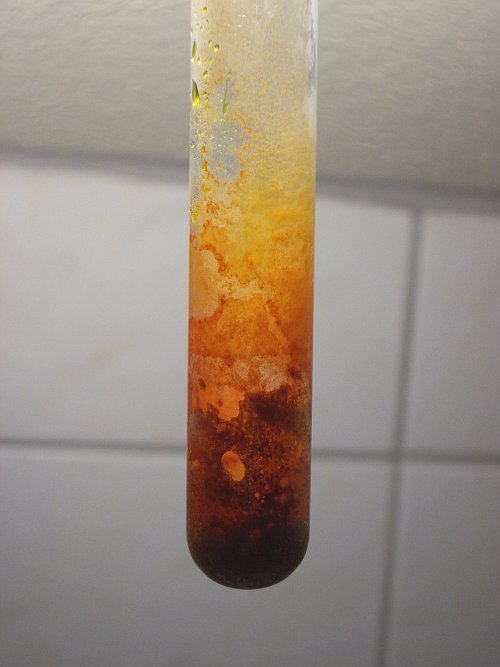
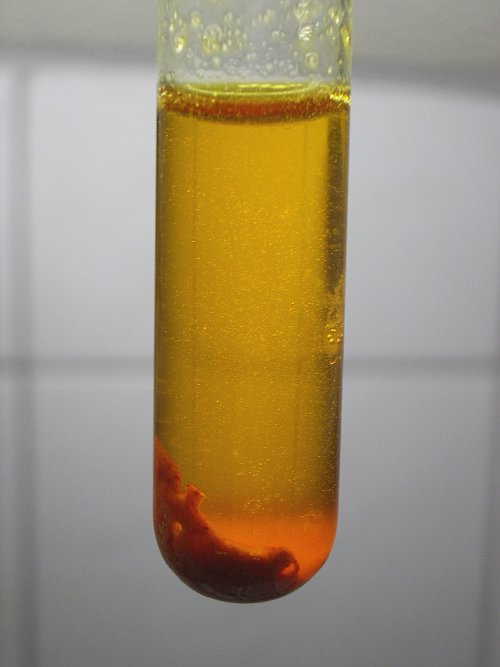
![]()
Chromyl chloride
This experiment is even more special than the experiment with the fluoride. A deep orange/brown gas is formed, which looks much like bromine. Also a droplet of a reddish/purple oil is obtained, which quickly evaporates, when it is in contact with air. Beware. Compared with the previous experiment, much more vapor can escape into the air. So, from the point of view of risk of inhaling hexavalent chromium, this experiment is more risky. Fortunately, no fluoride vapors are formed in this experiment.
![]() Put some pure table salt (sodium chloride) and some finely
powdered potassium dichromate in a small bottle. Total amount of chemicals,
again should not exceed 200 mg.
Put some pure table salt (sodium chloride) and some finely
powdered potassium dichromate in a small bottle. Total amount of chemicals,
again should not exceed 200 mg.
![]() Add
approximately 1 ml of concentrated sulphuric acid and quickly cap the bottle
loosely. When this is done, then immediately a mix of hydrogen chloride and
chromyl chloride is formed. A deep orange/brown vapor slowly moves upwards
through the small bottle and within a few tens of seconds, it is completely
filled with a nice colored vapor. At the glass walls, some of the vapor forms
reddish purple oily droplets and on top of the sulphuric acid, also some of the
oil can be observed.
Add
approximately 1 ml of concentrated sulphuric acid and quickly cap the bottle
loosely. When this is done, then immediately a mix of hydrogen chloride and
chromyl chloride is formed. A deep orange/brown vapor slowly moves upwards
through the small bottle and within a few tens of seconds, it is completely
filled with a nice colored vapor. At the glass walls, some of the vapor forms
reddish purple oily droplets and on top of the sulphuric acid, also some of the
oil can be observed.
The result of these two steps is shown below in the following few pictures. The left picture shows the little bottle with some salt and potassium dichromate in it, the middle and right pictures shown the bottle with the mix, after adding the concentrated sulphuric acid.
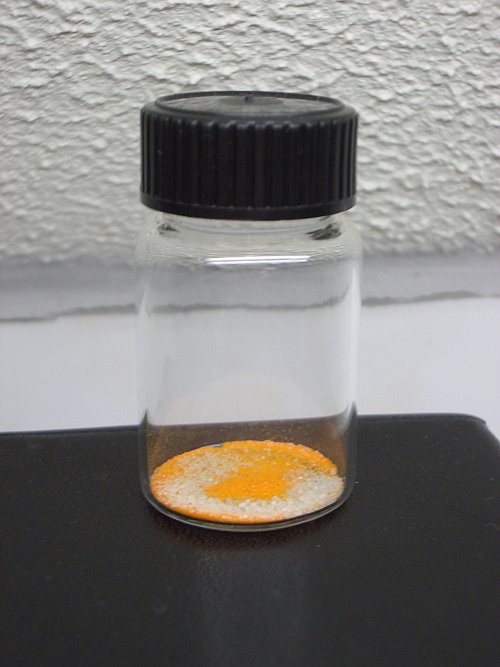
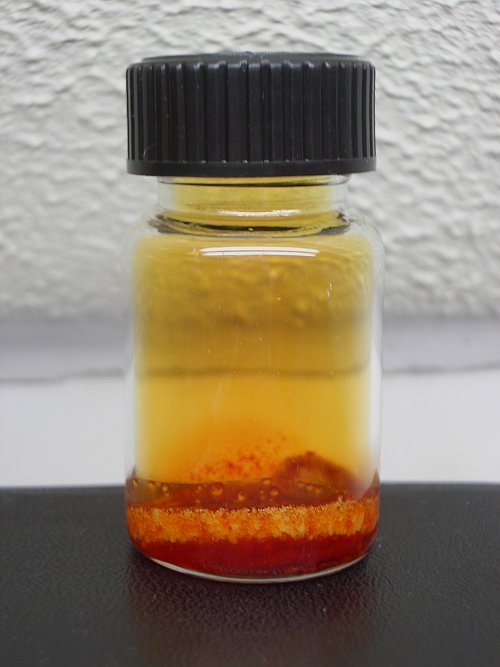
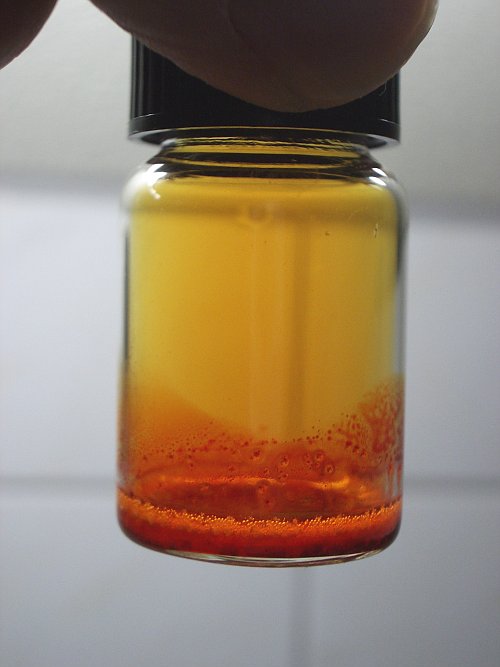
When the bottle is opened, then one can clearly see a yellow/orange vapor coming out of the bottle. One can also see the fuming of the hydrogen chloride, when it comes in contact with humidity in the air.
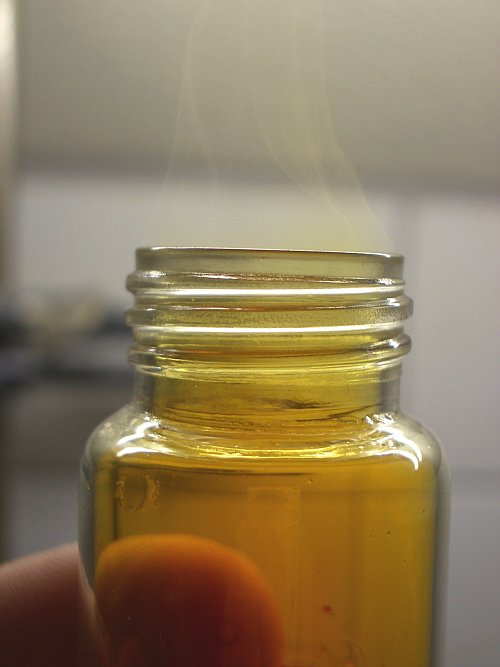
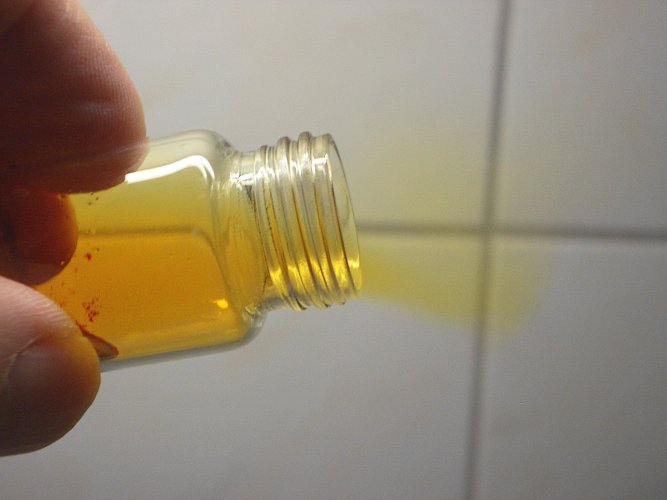
At the surface of the liquid in the bottle, one can also see oily droplets clearly. These oily droplets are shown in the last large picture. These droplets are liquid chromyl chloride. This experiment clearly shows that chromyl chloride is a very volatile liquid at room temperature.
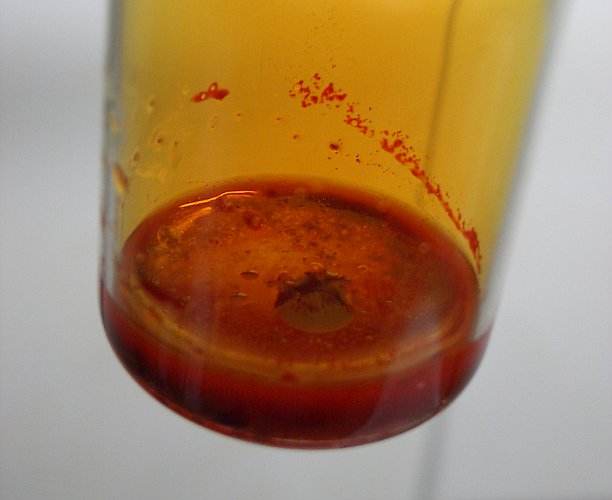
Remark: When the bottle with chromyl chloride is allowed to stand for a few hours, then the liquid has turned much darker brown, almost black and the vapor above the liquid has become lighter. This is due to the fact that the chromium in the +6 oxidation state slowly oxidized the chloride in the HCl and NaCl. The dark color is caused by formation of trivalent chromium, which is very dark, when mixed with remaining hexavalent chromium. That effect also is shown in another experiment with dichromate.
![]()
Discussion of results
![]() Chromium can form volatile compounds of the form CrO2X2,
with X being the element fluorine or chlorine. Especially the chlorine-compound
is strongly colored and is very volatile.
Chromium can form volatile compounds of the form CrO2X2,
with X being the element fluorine or chlorine. Especially the chlorine-compound
is strongly colored and is very volatile.
The reaction equation for the formation of the compounds is as follows:
K2Cr2O7 + 6H2SO4 + 4NaX → 2CrO2X2 + 4NaHSO4 + 2KHSO4 + 3H2O
H2SO4 + NaX → NaHSO4 + HX
Both reactions occur at the same time. In practice, the reactions may even be more complicated, e.g. HCl, formed in the reaction may also react with K2Cr2O7 and form CrO2Cl2, the water formed being taken away by sulphuric acid.